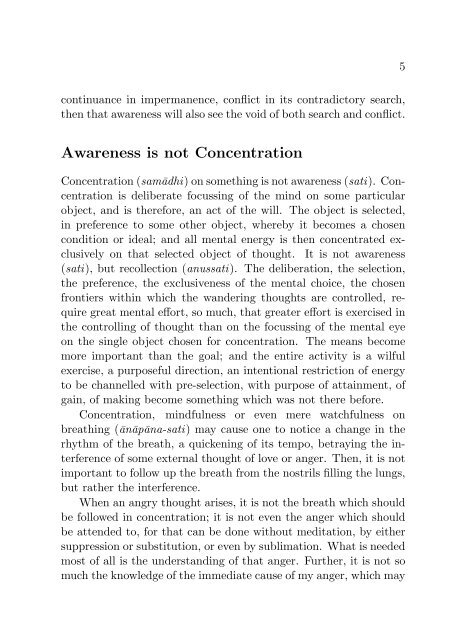Awareness in Buddhist Meditation
A detailed description of awareness in Buddhist Meditation.
A detailed description of awareness in Buddhist Meditation.
You also want an ePaper? Increase the reach of your titles
YUMPU automatically turns print PDFs into web optimized ePapers that Google loves.
5<br />
cont<strong>in</strong>uance <strong>in</strong> impermanence, conflict <strong>in</strong> its contradictory search,<br />
then that awareness will also see the void of both search and conflict.<br />
<strong>Awareness</strong> is not Concentration<br />
Concentration (samādhi) on someth<strong>in</strong>g is not awareness (sati). Concentration<br />
is deliberate focuss<strong>in</strong>g of the m<strong>in</strong>d on some particular<br />
object, and is therefore, an act of the will. The object is selected,<br />
<strong>in</strong> preference to some other object, whereby it becomes a chosen<br />
condition or ideal; and all mental energy is then concentrated exclusively<br />
on that selected object of thought. It is not awareness<br />
(sati), but recollection (anussati). The deliberation, the selection,<br />
the preference, the exclusiveness of the mental choice, the chosen<br />
frontiers with<strong>in</strong> which the wander<strong>in</strong>g thoughts are controlled, require<br />
great mental effort, so much, that greater effort is exercised <strong>in</strong><br />
the controll<strong>in</strong>g of thought than on the focuss<strong>in</strong>g of the mental eye<br />
on the s<strong>in</strong>gle object chosen for concentration. The means become<br />
more important than the goal; and the entire activity is a wilful<br />
exercise, a purposeful direction, an <strong>in</strong>tentional restriction of energy<br />
to be channelled with pre-selection, with purpose of atta<strong>in</strong>ment, of<br />
ga<strong>in</strong>, of mak<strong>in</strong>g become someth<strong>in</strong>g which was not there before.<br />
Concentration, m<strong>in</strong>dfulness or even mere watchfulness on<br />
breath<strong>in</strong>g (ānāpāna-sati) may cause one to notice a change <strong>in</strong> the<br />
rhythm of the breath, a quicken<strong>in</strong>g of its tempo, betray<strong>in</strong>g the <strong>in</strong>terference<br />
of some external thought of love or anger. Then, it is not<br />
important to follow up the breath from the nostrils fill<strong>in</strong>g the lungs,<br />
but rather the <strong>in</strong>terference.<br />
When an angry thought arises, it is not the breath which should<br />
be followed <strong>in</strong> concentration; it is not even the anger which should<br />
be attended to, for that can be done without meditation, by either<br />
suppression or substitution, or even by sublimation. What is needed<br />
most of all is the understand<strong>in</strong>g of that anger. Further, it is not so<br />
much the knowledge of the immediate cause of my anger, which may

















